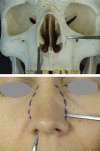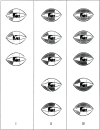Complications of Internal Continuous and Perforating External Osteotomy in Primary Rhinoplasty
- PMID: 28713706
- PMCID: PMC5506350
Complications of Internal Continuous and Perforating External Osteotomy in Primary Rhinoplasty
Abstract
Background: Osteotomy is one of the major steps in rhinoplasty. The aim of study was to compare edema and ecchymosis after external and internal lateral osteotomy in patients who underwent rhinoplasty.
Methods: Based on a prospective randomized clinical trial, 168 osteotomies were performed through an external route in a perforating fashion and internal route in a continuous fashion at right or left side respectively in any patient. Subjective scoring system was applied to evaluate edema and ecchymosis on 1st, 3rd, 7th, and 30th days after surgery.
Results: Edema and ecchymosis were the same in both types of osteotomies.
Conclusion: Regarding edema and ecchymosis, there was not any significant difference between external and internal osteotomies in rhinoplasty.
Keywords: Complication; Continuous; Osteotomy; Perforating; Rhinoplasty.
Conflict of interest statement
The authors declare no conflict of interest.
Figures








References
-
- Rees JT, Griner NR, Remmler DJ. Steps for a safer method of osteotomies in rhinoplasty. Laryngoscope. 1987;97:746. - PubMed
-
- Ford CN, Battaglia DG, Gentry LR. Preservation of periosteal attachment in lateral osteotomy. Ann Plast Surg. 1984;13:107. - PubMed
-
- Tardy MA, Denneny JC. Micro-osteotomies in rhinoplasty. Facial Plast Surg. 1984;1
LinkOut - more resources
Full Text Sources
Miscellaneous
